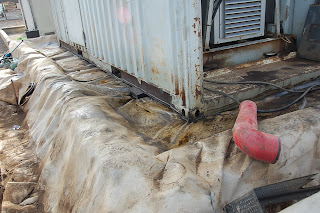I am sure everyone at one time in their life has wondered how a fuel spill is handled by the DoD in one of those far off third world countries. Spent a sleepless night just pondering that very topic. Okay, perhaps not, but in case the thought passes quickly by, you can at least know how I dealt with it.
First of all we know that the DoD operates under one of two different legal guidance documents; Overseas Environmental Baseline Guidance Document (OEBGD), or a Final Governing Standard (FGS). The difference between the two is that the FGS has been negotiated and the OEBGD has not. Not that not being negotiated makes it less of a document, but it is in practice less appreciated by those who it covers. A FGS has the power of a nation to nation treaty, so it makes it a bit more appreciated, if you follow my meaning here.
The OEBGD covers all the primary environmental categories that would be typically found at a installation, but it does so in a generic manner. It does actually reference US regulations, but most people who use it on a daily basis at the installation level (and most of the higher ups) do not understand the intricacies of how referencing makes those regulations applicable. The thing is that this is a self enforcement document, in that the DoD enforces it against itself. Similar to the guy who is given a rule book and told that when he breaks the rules he is to punish himself, and he determines how harshly. Really it is that simple.
A FGS on the other hand gives the host country some latitude to do some of that enforcing. It also is tailored to that particular country, along with the specific activities that are to occur at that installation. It may be more stringent than US laws, but never less. So it is not uncommon for installation personnel to be annoyed that they maybe held to a different enforcement standard than a local. But in actuality this is the same situation that occurs in the states, as most all regulators perceive the DoD to be the worse environmental violators in the area--this is a fact about regulators. So regulators are the same no matter where you go, applying the law unequally; this is life.
Now back to my fuel spill. In the location I am at there is currently no reliable energy sources, so everyone uses large diesel generators for power. And we have to have power to keep our ACs and refrigerators running, or else it would get very hot and uncomfortable. I also need to heat water for my green tea habit.
Okay so we have four generators for our compound; compound sounds so exotic. The largest generator had a fuel filter that broke and released an unknown quantity of fuel, as we didn't know when it happened. Most all generators have secondary containment of some sort, not all as this rule is not always equally applied; again this is life. The secondary containment for most stationary generators such as this one is simply made of concrete; yes I know it should be sealed but it is not, this is life.
When I was notified about the spill I went out and found that the fuel had been contained, and never reached the top of the containment unit. But somehow some quantity had escaped and contaminated soil at two different locations; concrete not sealed hmmmmm I wonder how the spill occurred. The soil in this area does not absorb anything very well, so the fuel was standing free on top. It didn't look like a lot at the time (you can read where this is going). So I got a couple of workers to get shovels and directed them to put the wet dirt into the bags. As they dug the free product continued to ooze up. Plastic bags were not going to cut it.
As part of a spill response it is required to report the spill to the facility when a reportable quantity is reached; part of the spill plan that is written for the installation and a specific one is written for each tenant. This spill appeared to be over 20 gallons so I then sent a email off to the environmental officer to report. In locations such as this there are no formal release reporting forms, so I made one up. I provided information related to how I thought the release occurred, and what I was doing to cleanup it up.
The level of restoration is of course not equal to that found in the US. I had the workers remove all the grossly contaminated soil, which went down nearly three feet. This soil was placed into 55 gallon drums that were transported to the installation's hazwaste storage area. Typically contractors are responsible for paying for disposal of hazwaste, but as there are no 'legal' hazwaste companies in the country the installation is handling the disposal of this waste.
Keep in mind that contracting away of responsibility for any waste is not defensible in court, and that applies to oversea operations as well. A DoD installation is assumed to be under US regulations no matter if it is simply expeditionary or enduring. The practical enforcement of those regulations are vague, and it is only hoped that the DoD would enforce.
Hazwaste is transported to a legal hazwaste disposal facility in another country. The process this takes is submitting paperwork with the local country and any port that the waste may encounter, as the Basel Agreement affects the movement of this waste even if the US is not a signatory. This can make the movement a logistical nightmare, as the signatory countries tend to make it tough for the non-signatory country (USA) to move waste through their country.
My hands still smell of diesel...








No comments:
Post a Comment